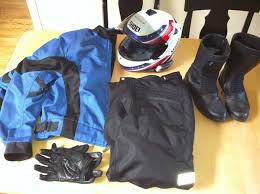Planning A Motorcycle Road Trip?
Are you planning for a long road trip? How do you prepare for it? Did you book your accommodations already? Have you mapped out all the spots you want to visit? What are the things you’ve packed? Cell phone, map, snacks, tent (or hotel money), flashlight, trash bags, extra clothes. . .
Planning plays a major role in the success of your motorcycle trip. If you are going for a long road trip, it is very possible to meet unexpected events along the way.
Of course you are ready for rain; right? What if it suddenly rains? Do you have your motorcycle rain suit?
Really, you can’t expect rain to give way to your plans. In fact, it is something that most motorcycle riders dread – the dark clouds ahead; the sudden drop in temperature. You know that despite the good weather forecast, you should prepare for rain. Actually, you should prepare for a bad day; anything can happen on the road.
What type of motorcycle gear?
When choosing a motorcycle rain suit, remember to consider safety over fashion. In other words, your motorcycle rain gear will not only keep you dry and warm but safe also. Riding in the rain presents a lot more problems. Aside from getting wet and feeling miserable, you have less traction from the road and less visibility. All of these will challenge your riding skills as well as your safety.
You want to be really efficient?
Choose a rain suit that will double as protective gear. A combo suit can protect your body from unexpected falls or accidents while keeping you warm and dry in tough weather.
Motorcycle rain suits are made from different materials. For protection against abrasion and other injures in case of unexpected fall, choose leather or synthetic rain suits. Although leather is the number one choice of most riders, rain suits made from synthetic materials can protect you just as well.
You are going to find a one piece or two piece rain suit but do not forget to choose one that have extra reinforcement in the knee and hip area. In a one piece rain suit, make sure that it can be connected to your jacket to avoid water from seeping through. Choose a motorcycle rain suit that fits perfectly but does not hinder your movement. The number one problem with riding in the rain is visibility. You must wear bright colored rain suit so that other riders can see you in the rain.
Rain Boots and Gloves
Expect that when the road is wet, your bike may slide and in order to protect the lower part of your body, wear quality motorcycle rain boots too. Good quality rain boots are made from high quality and waterproof material. It must be made from thick and flexible leather also. It should be resistant to water, oil and other petroleum products.
Aside from motorcycle rain boots and suit, you also need to protect your hands thus wearing leather gloves is a good solution. These will protect your hands from tearing and will give you extra grip of the controls when riding in the rain.
When choosing a motorcycle rain suit, remember to consider protection over fashion. One more thing, consider safety over fashion. In other words, your motorcycle rain gear will not only keep you dry and warm but safe also. Riding in the rain presents a lot more problems. Aside from getting wet and feeling miserable, you have less traction from the road and less visibility. All of these will challenge your riding skills as well as your safety.
Helmet
Now, the most important part of your body you must protect is your head. Wear a helmet to protect your head from head injuries. Now because it’s raining and it’s important to see the road clearly, you need to have a face shield. A full-face helmet with face shield is recommended for maximum safety.
When going out for a motorcycle ride, whether it’s a short or long ride, you are advised to wear protective gear. There are lots of motorcycle clothes and gear available in the market today. Take some care and precaution when choosing the kind of gear to purchase. It’s your own personal insurance on a bad day.



